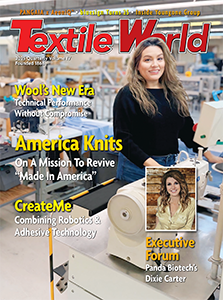ALBSTADT, Germany/ATLANTA — June 21, 2018 — In Atlanta from May 22-24, 2018, the Texprocess Americas and Techtextil North America trade fairs were held at the exhibition site of the Georgia World Congress Center. Groz-Beckert was represented with its product sectors Sewing, Felting and Carding and welcomed around 500 guests at its booth.
For Groz-Beckert this years’ exhibition was very successful with an increased visitor number compared to 2016. One reason was that the fairs did not overlap with the IDEA as in 2016. Furthermore, the automation and filtration sector are becoming more and more important, which attracted more visitors than in the years before. With a two-thirds majority, visitors at Groz-Beckert’s booth were mainly from the US but also more guests came from Central and South America than in 2016.
Groz-Beckert presented the product sectors Sewing, Felting and Carding to its visitors. The product sector Sewing focused on the online Customer Portal, where the customers have access to an online product catalog, information on products and services available 24/7 as well as live information on the active product range. Furthermore, the trolley Quality Management INH (Ideal Needle Handling) with major benefits such as problem-free and timesaving handling of broken and damaged sewing machine needles was presented. The INH process provides a uniform procedure to satisfy the different guidelines of brand owners, helping to reach the targets of environmentally appropriate handling and increase productivity.
The product sector Felting presented its latest innovation “dur”. A patented manufacturing process in combination with a new base material is the foundation for an increase in service life of up to 30 percent and improved corrosion resistance.
Groz-Beckert’s product sector, Carding, focused on the aspects of increased performance and raw material savings: The high-performance worker and doffer wires SiroLock® and EvoStep®. A unique exhibit with 3D models brought the special card clothing series to life for visitors.
For Groz-Beckert the Texprocess Americas und Techtextil North America 2018, were the most successful textile shows in Atlanta so far.
Posted June 21, 2018
Source: Groz-Beckert




